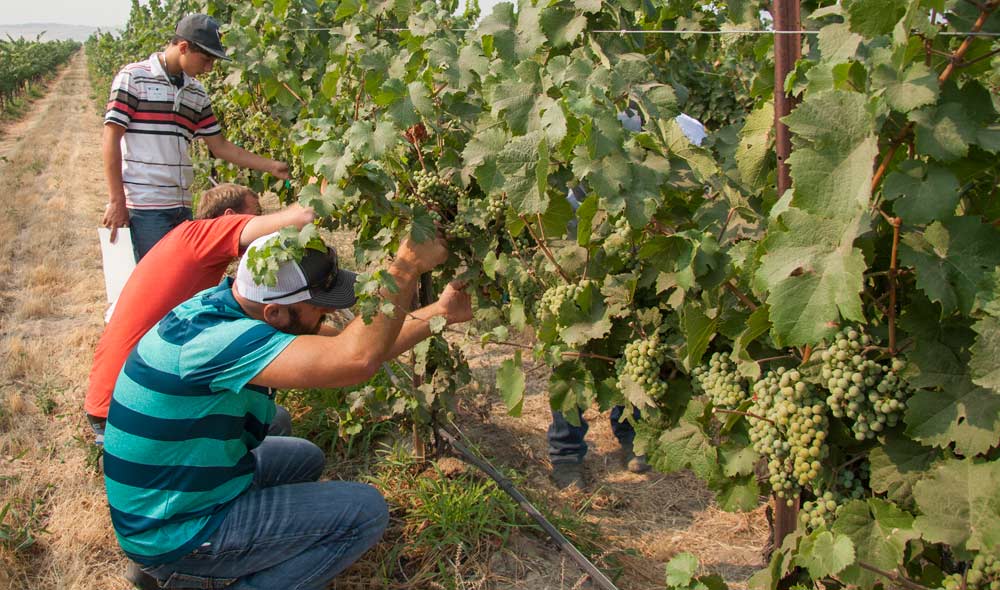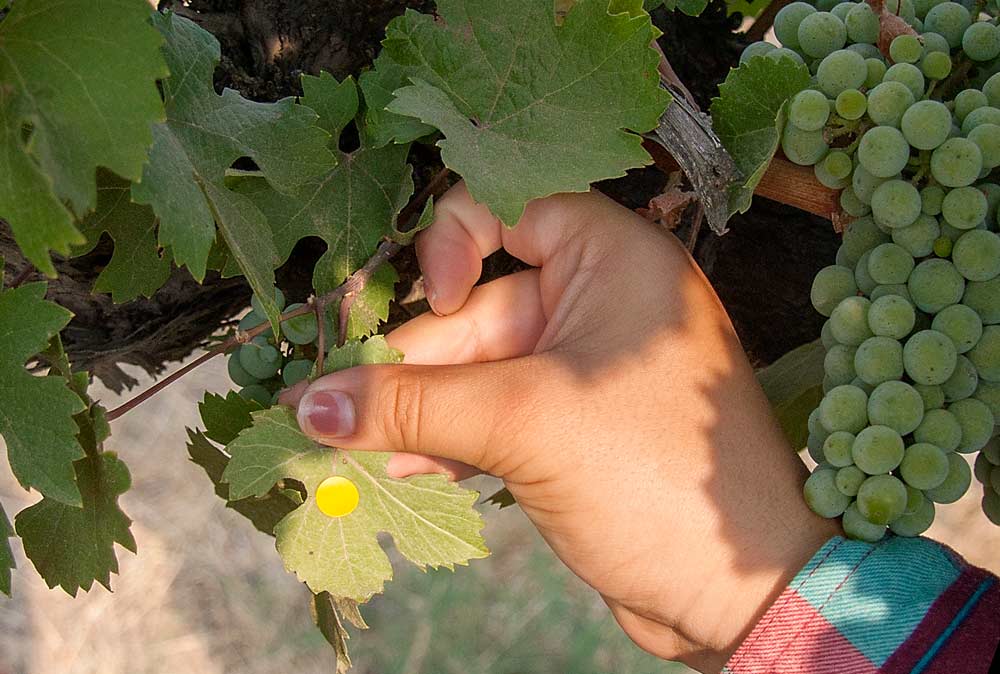
Chris Larson (front), Parker Fannin, and Joey Cotta test their scouting skills during a Washington State University and Washington State Grape Society viticulture and enology field day at Columbia Crest Vineyards in Paterson, Washington, in August. (Kate Prengaman/Good Fruit Grower)
Vineyard scouts found an unexpected presence in the Riesling block: white and orange sticky dots.
No, the dots didn’t require any pesticide plan, but they did serve to test the pest and disease scouting skills of attendees at a field day organized by the Washington State Grape Society and Washington State University at Columbia Crest Vineyards in Paterson, Washington.
Scouting can take many forms — from randomly strolling down a row to methodically giving every fifth vine a detailed search — but as the sticky dot exercise demonstrated, you get better results by matching the scouting method to the patterns of particular pests.
WSU extension viticulturist Michelle Moyer introduced the training session by describing common pest distribution patterns and the pros and cons of different scouting methods. Many people believe that random sampling is the best way to get unbiased data, but Moyer said it rarely turns out that way.
“The problem is that humans are not random. If you send people out to collect average clusters, most people will be drawn to clusters further along on veraison. Humans are always drawn to bright colors or larger areas,” she said. “We are visually drawn to vines that have more mildew or more mites.”
That’s why she advocates for other scouting methods, such as planning to sample on an interval, which is known as stratified sampling, repeatedly checking on the same sentinel vines throughout the season, or moving in a W-pattern throughout the vineyard.
Sentinel vine scouting works well in a uniform vineyard, especially for tracking phenology and yield, but it’s not ideal for catching pests and diseases that may be scattered throughout a vineyard, Moyer said.
For that, she recommends stratified scouting to prevent bias and get the big picture.

Sara Ponce, a field technician for Ste. Michelle Wine Estates, finds a sticky dot in a Riesling block during a training session on vineyard scouting. The dots were part of an exercise demonstrating the importance of matching a scouting method to the distribution pattern of a sought-after pest.
(Kate Prengaman/Good Fruit Grower)
To complicate matters further, while some problems are randomly distributed through an orchard, such as mildew, others may be aggregated in a certain area that’s easily missed by scouts. Nematodes, for example, tend to be aggregated in the soil in certain areas.
“It’s one of the hardest to scout for or collect information on because you have no idea where they are aggregated,” Moyer said. You might get lucky and find the cluster with a few random samples, but it’s more likely that “you have to take a lot of samples to get any data on aggregates.”
Scouting in a W-pattern across a vineyard increases the odds that you’ll catch an aggregate pest, she said. But the technique, which was developed for soil sampling in row crops, is more of a hassle in vineyards as scouts have to duck under vines and trellises.
“It helps you avoid visual bias and edge effects, but it’s a pain in big blocks,” she told the field day attendees in August. “It works great in wheat fields.”
Still other problems may occur in a more regular pattern. That’s usually an indication of a human-caused problem, such as several rows planted with infected nursery stock or damaged irrigation equipment. Luckily, such patterns are often easily caught because people are good at recognizing patterns.
To set scouts up for success, Moyer also recommends preparing some basic tools: clicking counters, hand lenses, and lots of bright-colored lanyards so that small tools are easy to track. It’s also important to bring bags or small containers to bring back samples of damaged leaves or pests if you find something unusual.
“As an extension person who gets sent a lot of blurry pictures of things, let me tell you, sometimes it helps to have samples,” she said.
When field day attendees set off in small groups to scout for sticky dots, they were assigned to each use either a random, stratified or W-pattern scouting method to move through the vineyard.
Some came back having found just a few dots, and others found closer to a quarter of the 150 dots Moyer and her team had placed in the vines.
Some of that difference was attributable to participants’ own sampling experience and speed, but some groups also — unbeknownst to them — were looking for an aggregate dot pest whose clusters they never found.
“It takes a lot of time to effectively sample,” Moyer said after the groups revealed their scores. “And these are visible, large dots. Think about what you’d miss with a smaller pest.” •
Scouting for fungicide resistance
Scouting is inherently a visual exercise, and you can only record the pests, pathogens and phenology that you can see. Also invisible to the eye: any pesticide resistance building in your vineyard.
To get a better picture of the fungicide resistance building in Washington vineyards as a result of powdery mildew sprays, Washington State University is offering sample kits to growers.
When scouting for powdery mildew, you can use the kit to take a small sample of the mildew on your vines, said WSU extension viticulturist Michelle Moyer.
WSU will work with the U.S. Department of Agriculture to test the samples for resistance to what are known as FRAC 11 fungicides, the most resistance-prone class in Washington vineyards. The class, designated by the Fungicide Resistance Action Committee, refers to fungicides that function as quinone outside inhibitors (Qol), also known as strobilurins.
Moyer plans to use the data to map out problem areas for resistance in the state, a project funded by the Washington State Wine Commission. Kits are available free to Washington growers at WSU’s Irrigated Agriculture Research and Extension Center in Prosser.
– by Kate Prengaman






Leave A Comment